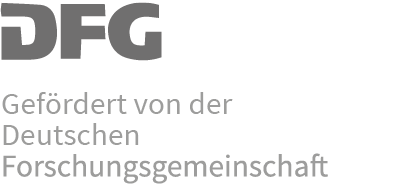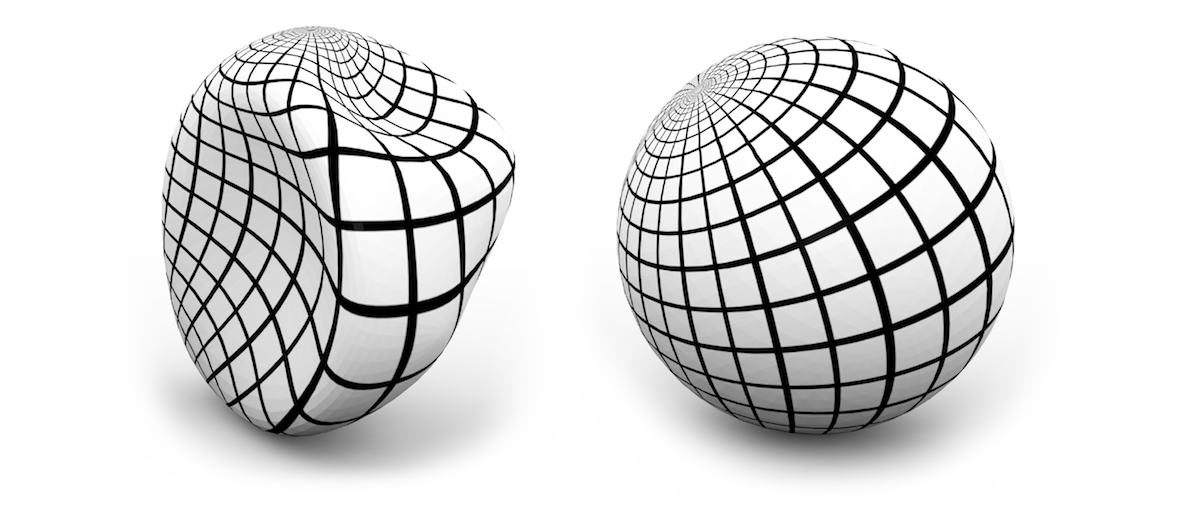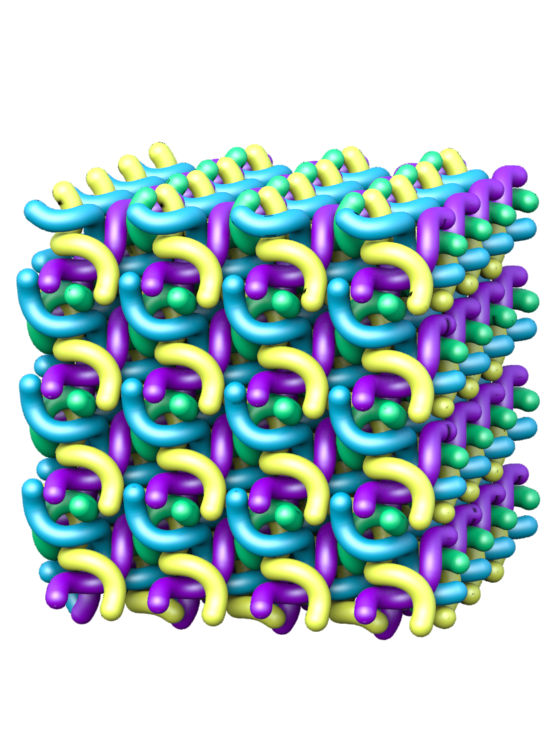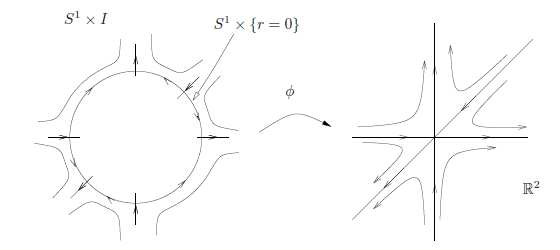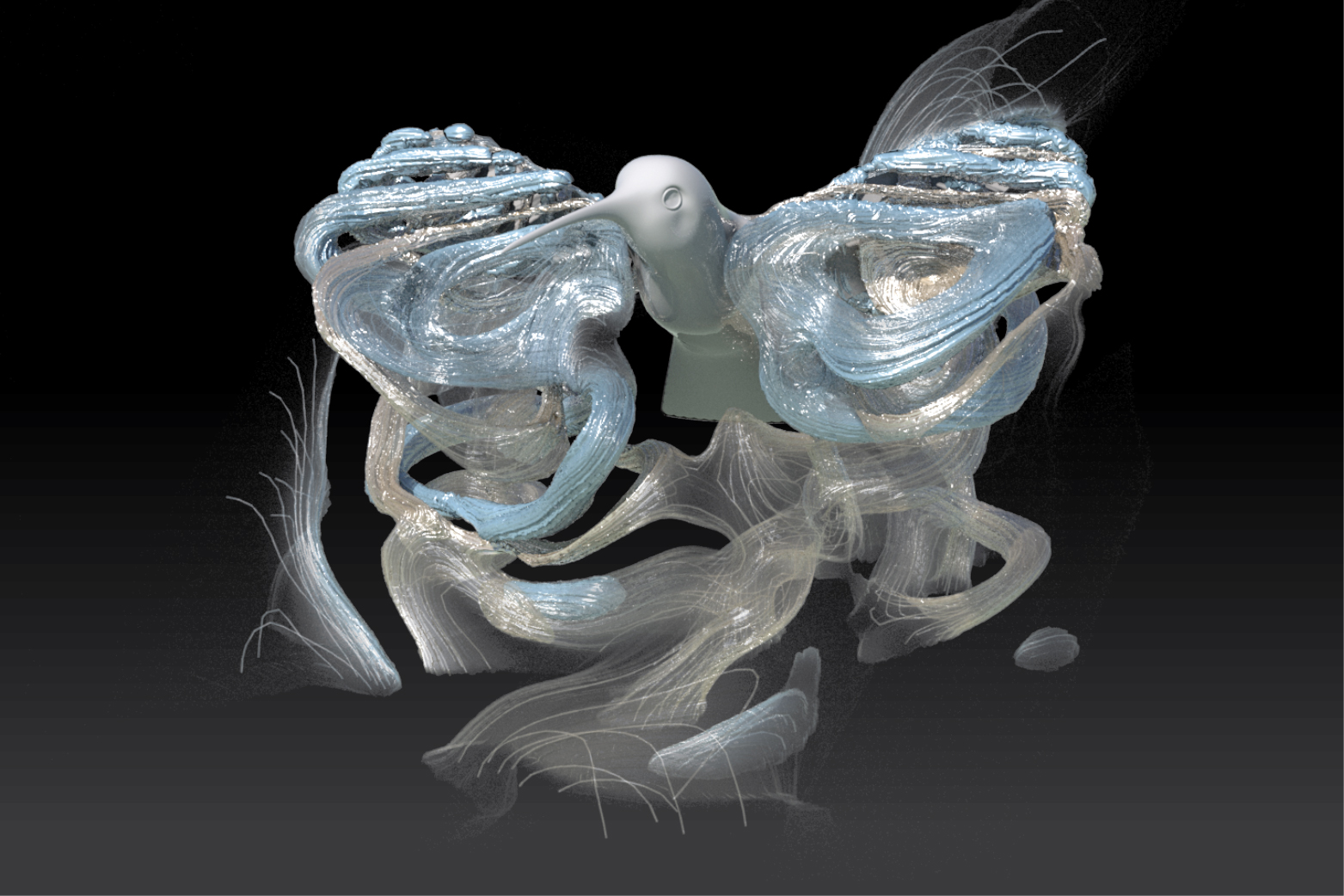Projects in Funding Period 2016 - 2020
Projects of the SFB Transregio 109 in Funding Period 2016 - 2020
A01: Discrete Riemann Surfaces (continued)
- Investigating the Facets of Discrete Complex Analysis
- Principal Investigators: Alexander Bobenko, Ulrike Bücking, Boris Springborn
- Investigators: Niklas Affolter, Felix Günther, Hana Kouřimská, Carl Lutz, Isabella Retter, Stefan Sechelmann, Lara Skuppin, Ananth Sridhar
-
Riemann surfaces arise in complex analysis as the natural domain of holomorphic functions. They are oriented two-dimensional real manifolds with a conformal structure. Several discretizations of Riemann surfaces exist, e.g., involving discretized Cauchy-Riemann equations, patterns of circles, or discrete conformal equivalence of triangle meshes. Project A01 aims at developing a comprehensive theory including discrete versions of theorems such as uniformization, convergence issues and connections to mathematical physics.
A02: Discrete Parametrized Surfaces (continued)
- Developing a Theory of Discrete Surfaces with Constant Mean Curvature
- Principal Investigators: Tim Hoffmann, Alexander Bobenko
- Investigators: Benno König, Alexander Preis, Jan Techter, Zi Ye
-
In recent years, an exhaustive theory has been developed to understand and construct discrete minimal surfaces. We aim to produce something similar for the construction and classification of discrete surfaces with constant mean curvature (cmc). In particular, for discrete minimal surfaces the study of Koebe polyhedra that serve as Gauß maps has been fruitful - we are interested in analoga for discrete surfaces with constant mean curvature.
A03: Geometric Constraints for Polytopes (completed)
- Exploring the Subtle Interplay of Geometry and Combinatorics
- Principal Investigators: Günter Ziegler, Raman Sanyal, Carsten Lange
- Investigators: Spencer Backman, Philip Brinkmann, Joseph Doolittle, Moritz Firsching, Tobias Friedl, Jean-Philippe Labbé, Lauri Loiskekoski, Sebastian Manecke, Hannah Schäfer Sjöberg
-
This project is based on the observation that combinatorial and geometric features of polytopes are interlocked in many different, conceptually independent, ways. This interaction in both directions divides our project into two main strands, “Geometry → Combinatorics” and “Combinatorics → Geometry,” where the arrows may be read as “constrains,” “impacts,” or “restricts.” Both directions are pursued in parallel, and the focus of understanding the interactions was considerably furthered during the first funding period. We now joined by our Einstein Visiting Fellow Francisco Santos.
A05: Conformal Deformations of Discrete Surfaces (continued)
- The Construction of a Discrete Differential Geometry Version of Certain Conformal Deformations
- Principal Investigators: Ulrich Pinkall
- Investigators: Albert Chern, David Chubelaschwili, Wai Yeung Lam
-
Two geometries can be considered equivalent if there exists an angle preserving transformation between them; this is a so called conformal transformation. In the smooth case, conformal equivalences are quite well understood. However, mimicking their construction in the discrete case brought up not only interesting properties and algorithms, but also interesting problems - first and foremost the question of how to construct conformal deformations with certain prescribed properties.
A11: Secondary fans of Riemann surfaces (completed)
- Study the combinatorics and geometry of polyhedral fans whose cones correspond to ideal tesselations
- Principal Investigators: Michael Joswig, Boris Springborn
- Investigators: Robert Loewe, Frank H. Lutz
-
A famous construction of Gelfand, Kapranov, and Zelevinsky associates to each finite point configuration in $\mathbb{R}^n$ its secondary fan, which stratifies the space of height functions by the combinatorial types of coherent subdivisions. A completely analogous construction associates to each punctured Riemann surface a polyhedral fan, whose cones correspond to the ideal tessellations of the surface that occur as horocyclic Delaunay tessellations in the sense of Penner's convex hull construction. We suggest to call this fan the secondary fan of the punctured Riemann surface. The purpose of this project is to study these secondary fans of Riemann surfaces and explore how their geometric and combinatorial structure can be used to answer questions about Riemann surfaces, algebraic curves, and moduli spaces.
A12: Ropelength for periodic links (completed)
- Explore the idea of ropelength in periodic entanglement
- Principal Investigators: John M. Sullivan, Myfanwy Evans
- Investigators: Max Krause, Christodoulos Savva
-
Ropelength is a mathematical model of tying a knot or link tight in real rope: we minimize the length of a curve while keeping a unit-diameter tube around the curve embedded. We have previously developed a theory of ropelength criticality; this allows explicit descriptions of critical configurations of links like the Borromean rings and the clasp. These configurations, whose exact geometry is quite intricate, are conjectured to be minimizers, but only known to be critical. This project will move beyond three-dimensional Euclidean space to study the ropelength problem for links in a flat three-torus. These of course lift to triply periodic structures in Euclidean space, which can include both compact and noncompact components.
B02: Discrete Multidimensional Integrable Systems (continued)
- Classifying and Structuring Multidimensional Discrete Integrable Systems
- Principal Investigators: Yuri Suris, Alexander Bobenko
- Investigators: Raphael Boll, Matteo Petrera, Mats Vermeeren
-
In recent years, there has been great interest among differential geometers for discovered discrete integrable systems, since many discrete systems with important applications turned out to be integrable. However, there is still no exhaustive classification of these systems, in particular concerning their geometric and combinatoric structure. Here, we investigate and classify multidimensional discrete integrable systems.
B03: Numerics of Riemann-Hilbert Problems and Operator Determinants (completed)
- The Search for the Optimal Contour
- Principal Investigators: Folkmar Bornemann
- Investigators: Georg Wechslberger
-
Riemann-Hilbert Problems (RHP) are another way of expressing equations satisfying a special property and have some advantages over the traditional forms. Take for example an equation describing the motion of a water wave and its current state: Both the traditional form and the RHP form of the equation enables us to calculate the state of the wave at any point in time. But with the RHP form we can accomplish this without knowing or calculating anything about the state of the wave in between.
B08: Curvature Effects in Molecular and Spin Systems (continued as B08: Wigner crystallization)
- Understanding Crystallization
- Principal Investigators: Marco Cicalese, Gero Friesecke
- Investigators: Yuen Au Yeung, Annika Bach, Rufat Badal, Lucia De Luca, Dominik Jüstel, Gianluca Orlando, Franscesco Solombrino, Arseniy Tsipenyuk
-
Many basic phenomena in solid mechanics like dislocations or plastic and elastic deformation are in fact discrete operations: small breakdowns of perfect crystalline order. The goal of this project is thereofore to address the phenomenon of crystallization, and its breakdowns, from the point of view of energy minimization.
B09: Structure Preserving Discretization of Gradient Flows (continued)
- Analyzing Discrete Curves of Steepest Descent in Discrete Energy Landscapes
- Principal Investigators: Oliver Junge, Daniel Matthes
- Investigators: Daniel Karrasch, Horst Osberger, Simon Plazotta, Benjamin Söllner, Jonathan Zinsl
-
Many evolution equations from physics, like those for diffusion of dissolved substances or for phase separation in alloys, describe processes in which a system tries to reach the minimum of its energy (or the like) as quickly as possible. The descent towards the minimum is restrained by the system’s inertia. In this project, we discretize these evolution equations by optimizing discrete curves in a discrete energy landscape with respect to a discrete inertia tensor.
B10: Geometric desingularization of non-hyperbolic iterated maps (continued)
- A coherent theory for geometrically resolving singularities in time-discrete dynamical systems
- Principal Investigators: Christian Kühn, Yuri Suris
- Investigators: Maximilian Engel
-
Singularities are ubiquitous in dynamical systems. They often mark boundaries between different dynamical regimes and also serve as organizing centers for the geometry of phase space and parameter space. In this project, we aim to extend geometric desingularization methods developed in the context of continuous-time systems to various classes of discrete-time maps.
C01: Discrete Geometric Structures Motivated by Applications and Architecture (continued)
- Geometry Supporting the Realization of Freeform Architecture
- Principal Investigators: Alexander Bobenko, Helmut Pottmann, Johannes Wallner
- Investigators: Leonardo Alese, Wolfgang Carl, Felix Dellinger, Martin Kilian, Florian Käferböck, Klara Mundilova, Christian Müller, Davide Pellis, Thilo Rörig, Andrew Sageman-Furnas
-
Many of today's most striking buildings are nontraditional freeform shapes. Their fabrication is a big challenge, but also a rich source of research topics in geometry. Project A08 addresses key questions such as: "How can we most efficiently represent and explore the variety of manufacturable designs?" or "Can we do this even under structural constraints such as force equilibrium?" Answers to these questions are expected to support the development of next generation modelling tools which combine shape design with key aspects of function and fabrication.
C02: Digital Representations of Manifold Data (continued)
- Principal Investigators: Felix Krahmer, Gitta Kutyniok
- Investigators: Olga Graf, Sandra Keiper, Sara Krause-Solberg, Michael Sandbichler, Nada Sissouno
-
Whenever data is processed using computers, analog-to-digital (A/D) conversion, that is, representing the data using just 0s and 1s, is a crucial ingredient of the procedure. This project will mathematically study approaches to this problem for data with geometric structural constraints.
C03: Shearlet approximation of brittle fracture evolutions (completed)
- Principal Investigators: Massimo Fornasier, Gitta Kutyniok
- Investigators: Stefano Almi, Sandro Belz, Mauro Bonafini, Markus Hansen, Philipp Petersen, Mones Raslan
-
A brittle material, subjected to a force, first deforms itself elastically, then it breaks without any intermediate phase. A model of brittle fractures was proposed by Francfort and Marigo, where the displacement is typically a smooth function except on a relatively smooth jump set determining the fracture. In this project we intend to compare anisotropic and adaptive mesh refinements with adaptive frame methods based on shearlets. In particular, by taking advantage of the shearlet property of optimally approximating piecewise smooth functions, we aim at reaching not only a proof of the convergence of the frame adaptive algorithms but also their optimal complexity.
C04: Persistence and Stability of Geometric Complexes (continued)
- Principal Investigators: Ulrich Bauer, Herbert Edelsbrunner
- Investigators: Magnus Botnan, Benedikt Fluhr, Grzegorz Jablonski, Fabian Lenzen, Anton Nikitenko, Florian Pausinger, Abhishek Rathod, Hubert Wagner
-
The following more detailed questions are studied within this project: The definition and construction of geometric complexes from data. Topological persistence. The homology of dynamical systems. The convergence of variants of Crofton's formula obtained with persistent homology to compute intrinsic volumes. The approximation of persistent homology through simplification of the representative complexes.
C05: Computational and structural aspects of point set surfaces (continued as C05: Computational and structural aspects in multi-scale shape interpolation)
- Implementation of Manifold Structures in Point Clouds
- Principal Investigators: Konrad Polthier
- Investigators: Henriette-Sophie Lipschütz, Konstantin Poelke, Martin Skrodzki, Eric Zimmermann
-
Point set surfaces have a long history in geometry processing and computer graphics as they naturally arise in 3D-data acquisition processes. A guiding principle of these algorithms is the direct processing of raw scanning data without prior meshing. However, a thorough investigation of a differential geometric representation of point set surfaces and their properties is not available. Inspired by the notion of manifolds, we develop new concepts for meshless charts and atlases and use these to establish sound formulations of discrete differential operators on point set surfaces.
C07: Vorticity concentration for fluid simulation (continued as C07: Discretizing fluids into filaments and sheets)
- Development of new algorithms for fluid simulation, visualization and processing.
- Principal Investigators: Ulrich Pinkall
- Investigators: Albert Chern, Felix Knöppel, Christoph Seidel
-
One of the main problems in Fluid simulations for Computer Graphics is that large scale phenomena are often driven by structures like vortex filaments or vortex sheets which are thin in compare to feasible grid resolutions and quickly destroyed by numerical diffusion. In this project we develop new tools for fluid simulation, visualization and processing based on a quantum mechanical description of incompressible fluids, which is capable to reproduce phenomena driven by thin vortical structures faithfully even on coarse grids.
CaP: Communication and Presentation (continued)
- Research on Transporting Maths Content from the SFB to the Public
- Principal Investigators: Alexander Bobenko, Jürgen Richter-Gebert, Günter Ziegler
- Investigators: Stefan Auerbach, Stefan Auerbach, Ekaterina Eremenko, Anna Maria Hartkopf
-
Images from geometry can serve as a visual pathway into mathematics. In the SFB they are leading in particular into pioneer research. This is to be taken as an opportunity: We would like to learn more about how mathematics can be communicated by means of visual content. And we would like to communicate new results from the SFB.
II: Information Infrastructure (completed)
- Principal Investigators: Alexander Bobenko, Michael Joswig
-
We have developed the DGD Gallery as an online platform to store and present geometric models arising from the research within the SFB/TRR109. We are now transforming the DGD Gallery into a general service reaching beyond the SFB.
Z: Central Project (continued as Z: Central Tasks)
- Principal Investigators: Alexander Bobenko, Matteo Petrera, Marie-Luise Ehls
- Investigators: Olga Holtz, Daniel Karrasch, Andreas Loos, René Zander
-
Z02: Web based visualization of mathematics (completed)
- Principal Investigators: Jürgen Richter-Gebert
- Investigators: Aaron Montag, Michael Strobel
-
Many projects in the SFB/TRR 109 use computational experiments. This project provides a visualization platform that can be commonly used. For instance CindyJS is used as a viewer for 3D models and other interactive models in the DGD Gallery


